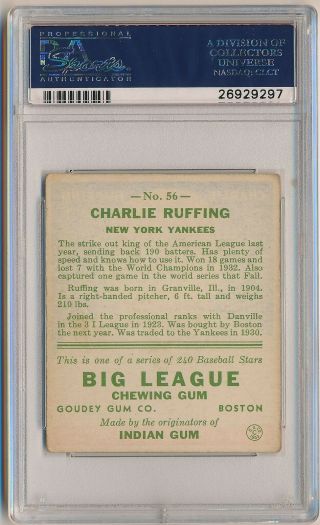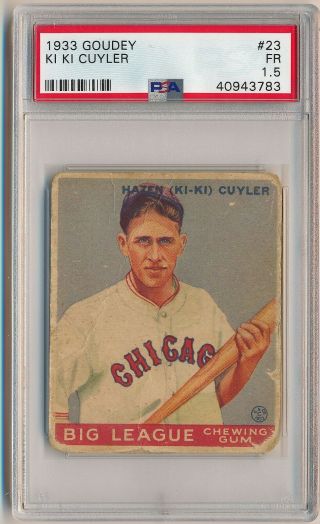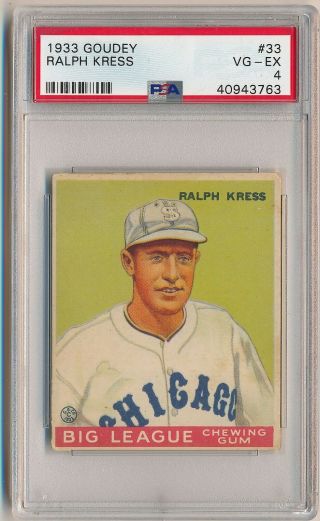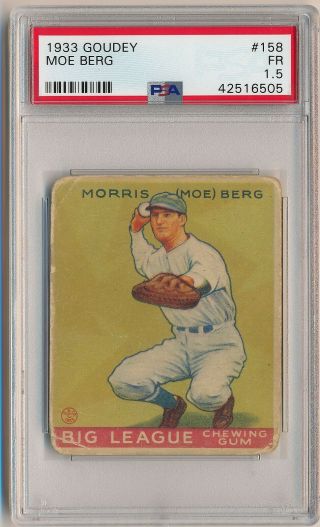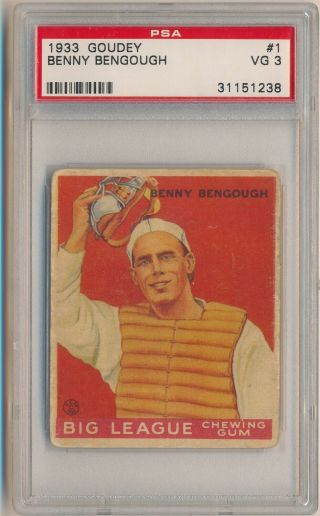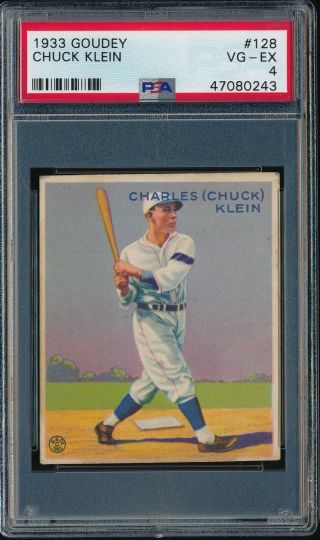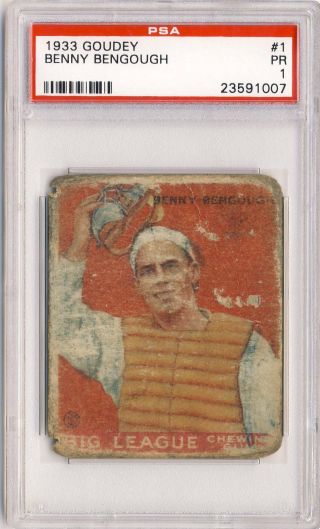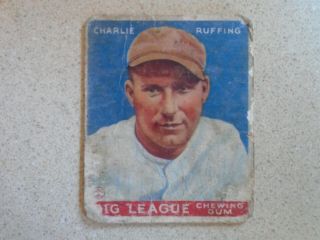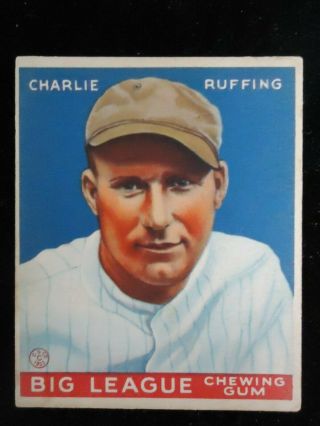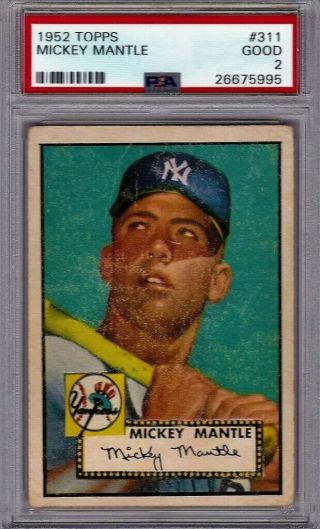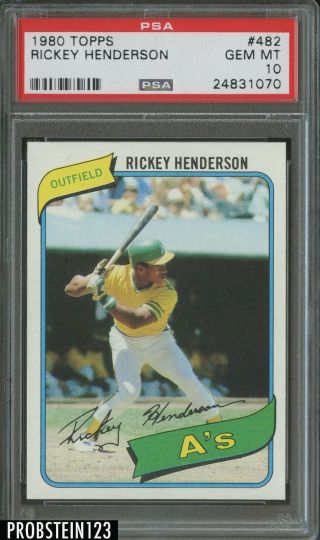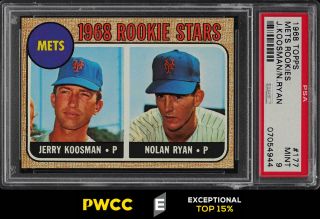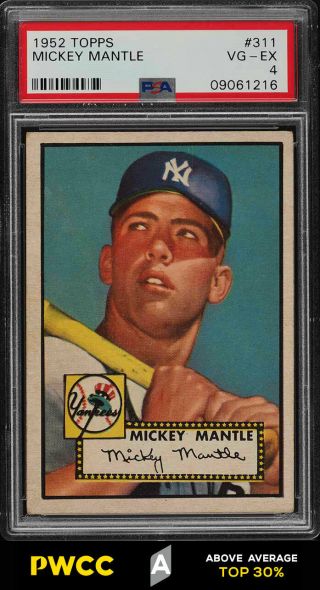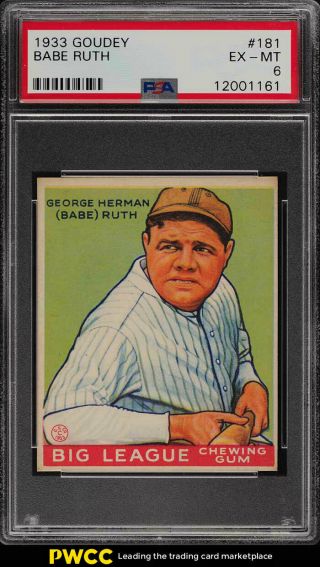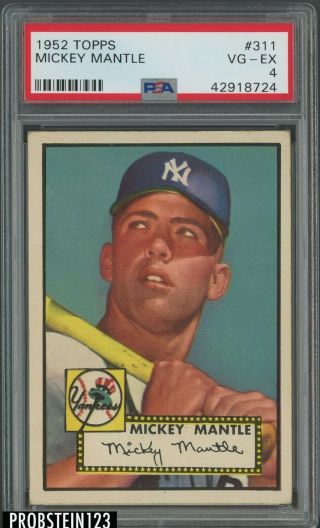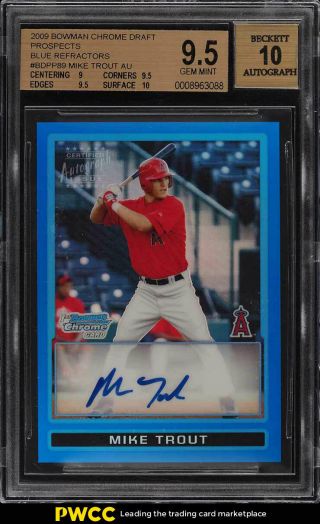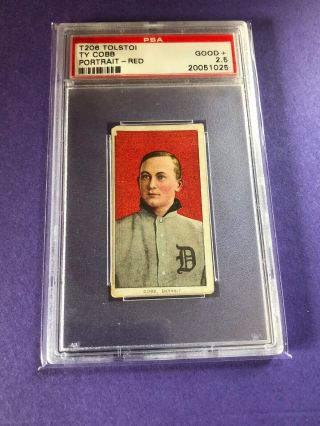RED RUFFING (CHARLIE) 1933 Goudey Gum 56 Graded PSA 3 VG YORK YANKEES HOF
Item History & Price
Welcome to iconsportscards. I specialize in vintage sets and factory certified autograph and memorabilia cards from Hall of Fame greats. I pride myself on customer satisfaction, and providing a quality product at a reasonable price. Thank you for viewing my item, Chrishttps://www.ebay.com/str/iconsportscardsAll sportscard singles ship for one low rate, no matter how many items you buy! Item Description:
You are bidding on a Professional...ly Graded RED RUFFING (CHARLIE) 1933 Goudey Gum #56 Graded PSA 3 VG NEW YORK YANKEES HOF. A very nice specimen from the 1933 Goudey Big League Chewing Gum card set, one of the most collectable sets of all time. Please scroll down for more about Goudey chewing gum baseball cards and the player.INTERNATIONAL BIDDERS WELCOMED!For more vintage Goudey cards, please check out my other items:https://www.ebay.com/str/iconsportscardsAbout the Set:
The 1933 Goudey (R319) set was produced by the Goudey Gum Company of Boston, MA and used to market tins/packs of chewing gum. The detailed artwork and vivid colors used to manufacture the cards are what make them a favorite among vintage collectors today. 1933 Goudey comprises of a 240 card set, each card measuring 2 3/8” x 2 7/8”. Key cards include Babe Ruth, who has four different cards in the set (53, 144, 149 & 181), Jimmy Foxx, Carl Hubell, Lefty Grove, Rogers Hornsby, Mel Ott, and many other legendary Hall of Famers. There is also a a very rare short-printed Nap Lajoie card (#106), which was not included in the regular print run of the set and is widely believed to have been intentionally left out in order to make it harder for collectors to finish the set.from Wikipedia:GoudeyFrom Wikipedia, the free encyclopedia Jimmy Foxx 1933 Goudey baseball card.The Goudey Gum Company was an American chewing gum company started in 1919. The company was founded by Enos Gordon Goudey (1863–1946) of Barrington Passage, Nova Scotia. Formerly an employee of Beemans, he opened a factory in Boston, Massachusetts in 1919 and later in Allston. It operated there from 1924 until it closed in 1962. Goudey sold the business in 1932 but he retained an interest as a consultant. On his retirement in 1933, William Wrigley Jr. dubbed him the "penny gum king of America". Today the Goudey name is mainly associated with its collectible baseball cards which were introduced in 1933. Goudey was the first American company to issue baseball cards with each stick of gum. (They had been available with cigarettes and certain lines of candy for many years.)[1][2]Goudey baseball cards Moe Berg Goudey cardMost of the unreleased cards, printing plates, and company archives were thrown away in the 1960s, although some were sold to collectors. Today, cards in good condition command a premium, especially those authenticated and graded by respected third-party graders. Hank Greenberg and Lou Gehrig are prominently featured in the Goudey cards of the 1930s, colorful cards with hand drawn portraits of the players. Other baseball hall of fame and interesting players depicted on Goudey gum cards from 1933 to 1941 include: Ty Cobb, Jimmie Foxx, Bill Dickey, Carl Hubbell, Lefty Grove, Dizzy Dean, Mickey Cochrane, Charlie Gehringer, Tony Lazzeri, Mel Ott, Joe Dimaggio, Hank Greenberg, "Ducky" Joe Medwick and Moe Berg.1933 set Nap Lajoie Goudey card, one of the rarest baseball cards.In 1933, Goudey produced a 240 card set, also called "Big League Chewing Gum". These cards, issued with bubble gum in each pack, were the first baseball gum cards. The 1933 Goudey set is considered one of the "Big Three" classic baseball card sets, along with the T206 and 1952 Topps sets.One of the rarest baseball cards from a mainstream set is card #106 from the 1933 Goudey set. It was not originally issued with the set, so collectors could not complete the set from packs. In 1934, Goudey issued card #106 for the 1933 set with retired player [Napoleon Lajoie]. Collectors that sent letters to the Goudey Gum Company complaining about the lack of a #106 card received it in the mail. The 1933 Goudey #106 Napoleon Lajoie is known as one of the "Big Three" baseball cards along with two cards from the T206 set depicting Honus Wagner and Eddie Plank.1934 setIn 1934, Goudey produced a 96 card set that was endorsed by two players, Lou Gehrig and Chuck Klein. The 1934 Goudey set is sometimes called the "Lou Gehrig" set. Interestingly, there are no Babe Ruth cards in the set. The Hank Greenberg rookie card is in this set.1938 setIn 1938, Goudey produced a 48 card set, also known as the "Heads-Up" set. The cards were numbered from 241 to 288, thus looking like Goudey was trying to extend the 1933 Goudey set. The first 24 cards in the set depicts pictures of players heads attached to a cartoonish body in baseball action. The next 24 cards in the set depicts the same players and the same poses. The difference is the next 24 cards include small cartoonish characters playing baseball along with captions. Joe Dimaggio, Jimmie Foxx, Hank Greenberg and Bob Feller are the big stars in this set.Canadian GoudeySimilar cards as the 1933 and 1934 Goudey sets were also released in Canada by the Goudey-owned World Wide Gum Co, of Granby, Quebec. They are sometimes known as Canadian Goudey sets. There were 94 and 96 cards in these sets, respectively. The 1933 World Wide Gum set was released with two different backs, one with both French and English, and the other with only English. There has not been definitive proof, but one theory is that the French-English backs were sold in Quebec and the English-only backs were sold in Ontario.List of Goudey baseball card setsYear of issuance, popular name and designation from The American Card Catalog:
1933 Goudey R319
1933 American R338
1933 World Wide Gum V353
1934 Goudey R320
1934 Goudey Premiums R390-1
1934 World Wide Gum V354
1935 Goudey 4-in-1 R321
1935 Goudey Premiums R390-2
1936 Goudey Wide Pens R314
1936 Goudey R322
1936 World Wide Gum V355
1938 Goudey "Heads-Up" R323
1939 Goudey Premiums R303
1939 World Wide Gum V351
1941 Goudey R324List of Goudey non-sport setsYear(s), name, quantity and dimensions.
1933 Boy Scouts (48) Size: 2⅛ × 3¼ in.
1933 Sea Raiders (48) Size: 2⅜ × 2⅞ in.
1933 World War Gum (96X 2⅞ in.
1933-40 Indian Gum (216) Size: 2⅜ × 2⅞ in.
1934 Big Thrill Booklets (24) Size: 2-5/16 × 2⅞ in.
1935 Majik Fold Pictures (9) Size: 5½ × 10¼ in.
1935 The Goudey Line R.R. 12 × 5 × 5 in.
1936 Auto License Plates (36) Size: 1½ × 3¼ in.
1936 History Of Aviation (10) Size: 5½" square
1937 Auto License Plates (69) Size: 1½ × 3¼ in.
1938 Auto License Plates (66) Size: 1½ × 3¼ in.
1938-39 Action Gum (96) Size: 2⅜ × 2⅞ inches
1939 Auto License Plates (30) Size: 1½ × 3¼ in.
1940 First Column Defenders (24) Size: 2½ × 3⅛ in.
1941 Sky Birds (24) Size: 2-5/16 × 2⅞ in.
1947-48 Indian Gum (96) Size: 2⅜ × 2⅞ in.
Jungle Gum (48) Size: 2⅜ × 2⅞ in.
Our Gang Gum Puzzles (25) Size: 3-11/16 × 5⅛ in.
Rainbow Radio Rascals (6) Size: 4⅜ × 5½ in.
Soldier Boys (24) Size: 2⅛ × 2⅞ in. Shipping and Handling:
Item will be packaged carefully and shipped securely. All graded cards will be secured with rigid cardboard inserts. All non-graded cards will be shipped securely in a penny sleeve and top-loader. All sportscard singles ship for one low rate, no matter how many items you buy! Combined shipping rates on lots may vary. Thanks! Thanks for viewing my item!Red RuffingFrom Wikipedia, the free encyclopedia Red RuffingPitcherBorn: May 3, 1905
Granville, IllinoisDied: February 17, 1986 (aged 80)
Mayfield Heights, OhioBatted: RightThrew: RightMLB debutMay 31, 1924, for the Boston Red SoxLast MLB appearanceSeptember 15, 1947, for the Chicago White SoxMLB statisticsWin–loss record273–225Earned run average3.80Strikeouts1, 987TeamsBoston Red Sox (1924–1930)New York Yankees (1930–1942, 1945–1946)Chicago White Sox (1947)Career highlights and awards6× All-Star (1934, 1938–1942)6× World Series champion (1932, 1936–1939, 1941)AL wins leader (1938)AL strikeout leader (1932)Boston Red Sox Hall of FameMonument Park honoreeMember of the National Baseball Hall of Fame Induction1967Vote86.93% (fifteenth ballot)Charles Herbert "Red" Ruffing (May 3, 1905 – February 17, 1986) was an American professional baseball player. A pitcher, he played in Major League Baseball (MLB) from 1924 through 1947. He played for the Boston Red Sox, New York Yankees, and Chicago White Sox. Ruffing is most remembered for his time with the highly successful Yankees teams of the 1930s and 1940s. Ruffing dropped out of school as a child to work in a coal mine in his native Illinois. He played for the mine's company baseball team as an outfielder and first baseman. After he lost four toes from his left foot in a mining accident, he became unable to run in the field, and switched to pitching. He played in minor league baseball in 1923 and 1924 before making his MLB debut with the Red Sox. After struggling with Boston, pitching to a 36–93 win–loss record, the Red Sox traded Ruffing to the Yankees, where he became successful, pitching as the Yankees' ace through 1946. After one season with the White Sox, Ruffing retired from pitching to work in coaching. He served as a bullpen coach for the White Sox, a pitching coach for the New York Mets, and a scout and minor league instructor for the Cleveland Indians. Ruffing was a member of six World Series championship teams with the Yankees. He also appeared in six MLB All-Star Games. He was inducted into the Baseball Hall of Fame in 1967. The Yankees dedicated a plaque to Ruffing in Monument Park in 2004. Early lifeRuffing was born on May 3, 1905, in Granville, Illinois.[1] He was one of five children. His parents, John and Louise Ruffing, emigrated to the United States from Germany.[1] Ruffing was raised in Coalton, Illinois[1] and Nokomis, Illinois.[2] He went to school in Nokomis.[1] His father was a coal miner, working in a mine in Coalton, Illinois, until he suffered a broken back. John became the superintendent of the mine, and also served as mayor of Coalton.[1] Red quit school at the age of 13 to work for his father in the mine, earning $3 per day ($50 in current dollar terms), working as a coupler. Conditions in the mine were dangerous. Red's cousin, who also worked in the mine, died in an accident.[1] He also played baseball as an outfielder and first baseman for the mine's company team, [1][3] and for a semi-professional team in Nokomis.[4][5] When Ruffing was 15 years old, he suffered an accident in the mine, where his left foot was crushed between two cars. Though the doctor was able to save his foot, Red lost four toes.[1][3] He was supposed to begin his professional baseball career in the Kentucky–Illinois–Tennessee League that year, but he found himself unable to run as fast as he previously could.[3] Doc Bennett, the manager of a nearby semi-professional team, suggested that Ruffing should try to continue pursuing a baseball career by becoming a pitcher.[1] Professional careerMinor leagues (1923–24)Bennett helped arrange for Ruffing to sign his first professional contract when he reached the age of 18. Ruffing signed with the Danville Veterans of the Illinois–Indiana–Iowa League, a minor league baseball team in the Class B designation level. With Danville, Ruffing had a 12–16 win–loss record. After pitching for Danville in the 1923 season, the Boston Red Sox purchased Ruffing from Danville for $4, 000 ($58, 820 in current dollar terms).[1][3] The Red Sox assigned Ruffing to the Dover Senators of the Class D Eastern Shore League to pitch at the start of the 1924 season.[1] He had a 4–7 record for Dover.[3] Major leaguesBoston Red Sox (1924–30)Ruffing made his major league debut with the Red Sox on May 31, 1924. He pitched without earning a decision in over 23 innings pitched, and had a 6.65 earned run average (ERA).[6] He saw regular playing time with the Red Sox over the next few years but had limited success. He had a 9–18 win-loss record with a 5.01 ERA in the 1925 season, as the Red Sox finished in last place in the eight team American League (AL).[7] Ruffing had a 6–15 win-loss record and a 4.39 ERA in the 1926 season, [8] and a 5–13 win-loss record with a 4.66 ERA in the 1927 season, [9] with the Red Sox finishing in last place both years. His best season to date, in terms of earned run performance, came in 1928, when he posted a 3.89 ERA. However, he led the AL in earned runs allowed, with 125, and had a 10–25 win-loss record, which led the AL in losses.[1][10] On a positive note, he also led the AL with 25 complete games.[4] As Ruffing had a .314 batting average during the 1928 season, the Red Sox and Ruffing considered having him shift to the outfield. The team decided against a position change due to the limitations of Ruffing's left foot.[1][3] The Red Sox chose Ruffing to be their Opening Day starting pitcher for the 1929 season.[11] During the 1929 season, he again led the AL in losses, with 22, and earned runs, with 135.[12] He won only nine games.[13] Ruffing often had difficulty pitching more than five innings in a game.[14] Someone in the Red Sox organization suggested to Ruffing that he should try to gain weight by drinking beer, which saw him grow from 185 pounds (84 kg) to 240 pounds (110 kg).[3] During the 1930 season, Bob Quinn, the owner of the Red Sox, was in debt and afraid he would lose the team due to foreclosure. To raise capital, he traded Ruffing to the New York Yankees for reserve outfielder Cedric Durst, $50, 000 ($749, 900 in current dollar terms), and a $50, 000 loan from Jacob Ruppert, the Yankees' owner.[1] Ruffing ended his five-and-a-half year tenure with the Red Sox with a 39–93 win-loss record;[3][4] his winning percentage (.289) was lower than that of the Red Sox during his tenure (.344).[1] New York Yankees1930–38Miller Huggins, who served as the Yankees' manager through 1929, had attempted to acquire Ruffing from the Red Sox for the last couple years of his Yankees' tenure. When Ruffing told him that he was considering moving to the outfield, Huggins told him he should continue as a pitcher.[3] Bob Shawkey, a former pitcher who succeeded Huggins as the Yankees new manager in 1930, had convinced Ed Barrow, the Yankees' general manager, to acquire Ruffing. Shawkey believed he could change Ruffing's approach to pitching to obtain better results.[14] Shawkey worked with Ruffing to change his pitching delivery, so that Ruffing used his body more. This helped Ruffing save his arm strength for the later innings of the game.[1][14] The trade of Ruffing for Durst is now reckoned as one of the most lopsided trades in baseball history; Durst was a reserve outfielder who always batted at the bottom of the lineup when he was used.[15] The 1930 season proved to be Durst's worst year in the majors.[16] Ruffing had a 0–3 record with the Red Sox before the trade. He won 15 games for the Yankees after the trade, losing only five games.[4][14] The Yankees chose Ruffing as their starting pitcher for Opening Day in 1931.[17] During the 1931 season, Ruffing had a 16–14 win-loss record with a 4.41 ERA. The Yankees finished the season in second place.[18] On August 13, 1932, Ruffing threw a complete game shutout and hit a home run in the tenth inning off of Washington Senators' pitcher Tommy Thomas to give the New York Yankees a 1–0 victory.[19] Ruffing became the first pitcher in major league history to win a game 1–0, hit a home run in the game, and strike out ten or more batters. Two other pitchers have since achieved this feat: Early Wynn in 1957, and Yovani Gallardo, who did it in 2009.[20] Ruffing won 18 games during the 1932 season. He had a 3.09 ERA, second in the AL only to Lefty Grove's 2.84. Ruffing had 190 strikeouts, which led the AL.[1][21] The Yankees won their first pennant since 1928. Ruffing won his first World Series game during the 1932 World Series against the Chicago Cubs.[22] He started Game One, and the Yankees swept the Cubs four games to zero.[23] Ruffing had a 9–14 win-loss record with a 3.91 ERA in the 1933 season, as the Yankees finished in second place in the AL.[24] He threw a one-hitter on June 20, 1934, against the Cleveland Indians.[25] Two weeks later, Joe Cronin selected Ruffing for the 1934 Major League Baseball All-Star Game. At that point, he had a 9–3 win-loss record on the season.[26] He finished the season with a 19–11 win-loss record, as the Yankees finished second in the AL.[27] Ruffing pitched to a 16–11 record in the 1935 season, as the Yankees again finished second in the AL.[28] His 3.12 ERA was third in the league, behind only Grove and Ted Lyons.[29] Ruffing won 20 games during the 1936 season.[4] His 3.85 ERA was the sixth-best in the league, and his 20 wins tied him for third place, with Johnny Allen and Wes Ferrell, behind Tommy Bridges and Vern Kennedy.[30] He started Game One of the 1936 World Series against the New York Giants, [31] but lost. The Yankees defeated the Giants four games to two.[32] In a salary dispute with the Yankees, Ruffing did not report to spring training, and he held out at the start of the 1937 season, missing the first month. He signed in May, receiving a $15, 000 salary ($261, 424 in current dollar terms).[33] Ruffing had a 20–7 win-loss record for the Yankees in 1937.[34] He finished with the fourth-best ERA in the league, 2.98, trailing Lefty Gomez, Monty Stratton, and Allen, and his 20 wins were second only to Gomez, who had 21.[35] His performance earned him eighth place in AL Most Valuable Player (MVP) Award voting.[36] He started Game Two in the 1937 World Series, earning the victory, as the Yankees defeated the Giants four games to one.[37] The Yankees started Ruffing on Opening Day for the 1938 season.[38] He was again named an All-Star during the 1938 season. Yankees' manager Joe McCarthy, who managed the AL team in the All-Star Game, chose teammate Lefty Gomez as the starting pitcher. As McCarthy did not believe in pitching two players from the same team in an All-Star Game, Ruffing did not appear in the game.[39][40] He led the AL with 21 wins in the 1938 season. He also tied for the AL lead in shutouts during with three, while his 3.31 ERA was third-best in the league, behind only Grove.[4][41][42] Ruffing pitched the opening game of the 1938 World Series against the Cubs.[43] He won two games in the series as the Yankees defeated the Cubs.[22][44] Ruffing finished fourth in AL MVP voting for the 1938 season.[45] 1939–46McCarthy named Ruffing to be the starting pitcher for the Yankees on Opening Day in 1939.[46] McCarthy, managing the AL All-Star team that year, also selected Ruffing as his starter for the 1939 MLB All-Star Game.[47] He missed several weeks late in the 1939 season due to an arm injury, [43] but managed to start Game One of the 1939 World Series. He defeated the Cincinnati Redlegs in that game, and the Yankees won the series in a four games to zero sweep.[48] Ruffing won 21 games during the 1939 season.[49] His four shutouts in the 1939 season again tied him for the AL lead, [4] while he finished second in wins behind Bob Feller, and fourth in ERA (2.93) behind Grove, Lyons, and Feller.[50] He finished fifth in the balloting for the AL MVP.[51] Ruffing was the Yankees' Opening Day starting pitcher in 1940.[52] He was named to the 1940 All-Star team, and Cronin, acting as manager, selected Ruffing as his starting pitcher.[53][54] Ruffing finished the season with a 15–12 win-loss record.[55] Ruffing was a member of the 1941 All-Star team as well, but he did not pitch in the game.[56] He had a 15–6 win-loss record during the 1941 season, and was named the starting pitcher for Game One of the 1941 World Series against the Brooklyn Dodgers.[57] Ruffing defeated the Dodgers, as the Yankees won the series four games to one.[58] Ruffing pitched for the Yankees during Opening Day of the 1942 season.[59] That year, he compiled a 14–7 win-loss record. He was again named an All-Star, and again did not pitch in the All-Star Game, which was started by teammate Spud Chandler.[60] Though teammate Tiny Bonham had a better season, pitching to a 21–5 win-loss record, McCarthy again chose Ruffing as his Game One starter for the 1942 World Series, [61][62] setting a record with six World Series Game One starts that stood until Whitey Ford started his seventh Game One in the 1963 World Series.[63] Ruffing defeated the St. Louis Cardinals in Game One, his seventh World Series victory. This set a record that was surpassed by Ford in 1960.[1] Ruffing pitched again in the Game Five, with the Yankees down three games to one. Ruffing lost the game, as the Cardinals defeated the Yankees to win the series.[22][64] After the 1942 season, Ruffing took a job with Vultee Aircraft, a defense contractor. Despite his age (37) and missing toes, a United States Army doctor certified Ruffing as Class 1-B in the Selective Service System, overruled Ruffing's personal physician, who had ruled Ruffing unfit for service. The Army decided that Ruffing could serve in a non-combat role.[1][65] Ruffing missed the 1943 and 1944 seasons due to his service during World War II. He served in the Sixth Ferrying Group of the Air Transport Command of the United States Army Air Forces at the rank of private. However, he did pitch for the Air Transport Command's baseball team, throwing a perfect game against Joe DiMaggio's team, [66] and leading his team to the championship against Ted Lyons' team.[67] In 1944, he played with an All-Star team for troops stationed in Hawaii.[1] Ruffing turned forty years of age during the war, resulting in his discharge in June 1945.[68][69] He rejoined the Yankees that month, signing for the same $20, 000 salary ($278, 336 in current dollar terms) he earned in 1942.[70] He made his first appearance with the Yankees since the 1942 season in July 1945.[71] Pitching for the Yankees as a spot starter in 1946, he had a 5–1 win-loss record and a 1.77 ERA when he suffered a broken kneecap from a line drive hit by Hank Majeski, and missed the remainder of the season.[1] In total, Ruffing won 231 games with the Yankees. This mark was the most in franchise history, until Ford surpassed it in 1965.[72] He remains the winningest right-handed pitcher in Yankees' history.[73] Chicago White Sox (1947)Suffering from recurrent knee injuries, the Yankees released Ruffing after the 1946 season. He signed with the Chicago White Sox for the 1947 season, [74] but continued to be limited by his knee. In May, the White Sox removed Ruffing from their active roster after he was hit in his bad knee with another line drive.[75] He rejoined the White Sox' active roster in July.[76] He pitched to a 3–5 win–loss record and a 6.11 ERA in nine games pitched on the season.[77] Ruffing retired after the 1947 season.[4] Career summaryRuffing finished his career with 273 wins, 225 losses, 1, 987 strikeouts and a 3.80 ERA.[4] He also had 16 saves.[78] Ruffing compiled 335 complete games in his 536 games started.[79] Ruffing could also handle the bat very well compared to most other pitchers, hitting 36 home runs and batting .269 in 1, 937 career at-bats. He hit over .300 in eight different seasons, and was frequently used as a pinch hitter in games he did not pitch.[4] He also played in the outfield in emergency situations.[80] Ruffing's home run total as a pitcher trails only Ferrell, Warren Spahn, and Bob Lemon.[81] Ruffing holds the AL record for most runs and earned runs allowed.[82] Ruffing threw a fastball, a "sharp" curveball, and a slider.[78] According to AL umpire Bill Summers, "[O]n account of Red Ruffing, the slider got to be the thing."[1] Joe Paparella, also an AL umpire, said "The first game I ever worked behind the plate in the major leagues was against the guy who invented the slider and had the best slider ever seen — Red Ruffing".[78] Coaching careerAfter he retired from pitching, Ruffing stayed with the White Sox organization to instruct their players. The White Sox named Ruffing the manager of their Class A minor league affiliate, the Muskegon Clippers of the Central League, for the 1949 season.[83] That season, the Clippers finished in fifth place out of six teams.[84] In 1950, Ruffing managed the Daytona Beach Islanders of the Florida State League, a Cleveland Indians' affiliate.[85][86] When Al Simmons retired from his coaching position with the Indians just before the 1951 season due to his failing health, bullpen coach Jake Flowers was moved to the third base coaching position, and Ruffing took over Flowers's duties.[86][87] From 1952 through 1961, Ruffing was a player personnel executive for the Indians. Ruffing returned to the baseball field serving as pitching coach for the expansion New York Mets in 1962, [88] which were run by George Weiss, the general manager, and Casey Stengel, the manager. Weiss and Stengel had held the same positions with the Yankees during Ruffing's tenure.[1] As a team, the Mets had a 5.04 ERA across the 1962 season, which was the worst in the major leagues. The job also involved scouting duties, which Ruffing did not like, and he retired shortly after the season ended.[1] He returned to baseball again for the 1969 season, at the request of former teammate Don Heffner, who was managing the Denver Bears of the American Association. Ruffing served as Heffner's pitching coach.[5] Personal lifeRuffing married Pauline Mulholland, a native of Chicago, at the end of the 1934 season. The couple settled in Long Beach, California.[3] When he worked for the Indians in the 1950s, the Ruffing family relocated to Cleveland. The couple had a son, named Charles, Jr.[1] Ruffing suffered a stroke in 1974, at the age of 68, which left him paralyzed on his left side. As a result, he used a wheelchair for the remainder of his life.[1][89] This was Ruffing's second stroke, and he also suffered from kidney and heart problems.[4] He contracted skin cancer, necessitating the partial amputation of one of his ears. He died on February 17, 1986, at Hillcrest Hospital in Mayfield Heights, Ohio, of heart failure.[1][90] HonorsIn balloting for the National Baseball Hall of Fame following his retirement, Ruffing often received votes from approximately 50% of the voters in the Baseball Writers' Association of America, short of the 75% required for induction. Bob Feller wrote an article in The Saturday Evening Post in 1962, calling Ruffing, Satchel Paige, and Luke Appling the three most deserving players who had yet to be elected.[1] The balloting of 1967 was Ruffing's final year of eligibility, as he had retired twenty years prior. Ruffing finished with 212 votes, tied with Joe Medwick for the highest vote count, but was seven votes short of the 219 required for induction.[91] However, a runoff election held the next month saw Ruffing into the Hall of Fame the next month.[92] During an Old-Timers' Day ceremony held on July 10, 2004 at Yankee Stadium, the Yankees dedicated a plaque in Ruffing's memory. The plaque is displayed in Monument Park.[73] ESPN.com ranked Ruffing as the ninth greatest Yankee of all time.[93] A museum in Nokomis, Illinois, the Bottomley-Ruffing-Schalk Museum, is dedicated to Ruffing and fellow Hall of Famers Ray Schalk and Jim Bottomley.[94]
00060




